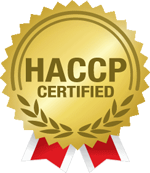Food Manager Course & Exam
Promo Code at Checkout: "train10off"

State Approved: Accredited by the International HACCP Alliance.
Live 24×7 Support:
1 (800) 442-1149
support@360training.com
Printable certificate available once you complete and pass the final exam.
Valid for 5 years.
Food Safety HACCP for Retail Food Establishments – 16hrs – $99.00
HACCP: The State-of-the-Art Approach to Food Safety – 4 hrs – $50.00
HACCP: Seafood – 1 hr – $70.00
HACCP Certification Course
HACCP: The State-of-the-Art Approach to Food Safe
Hazard Analysis Critical Control Point (HACCP) is recognized as the most efficient way to ensure the safety of food products. This course follows the classic approach to HACCP and covers the scientific basis and methodology of HACCP.
Learning Objectives
By the time you finish this course you will be able to:
- Identify the key points of HACCP
- Identify the causes of food borne illness
- Explain the 7 HACCP principles
- Apply standard operating procedures for food safety and food defense in your operation
- Follow prerequisite programs for food safety
- Identify the three classifications of recipes
- Apply critical control limits
- Determine critical control points
- Determine effective corrective actions
- Complete monitoring forms
Course Outline
The course consists of the following seven units:
- Introduction to HACCP
- Food Borne Illness
- The Seven HACCP Principles
- Identifying Hazards and Determining Critical Control Points
- Critical Limits, Monitoring and Corrective Actions
- Verification and Record Keeping
- Overcoming Barriers to HACCP Implementation
Need for HACCP
New challenges to the U.S. food supply have prompted FDA to consider adopting a HACCP-based food safety system on a wider basis. One of the most important challenges is the increasing number of new food pathogens. For example, between 1973 and 1988, bacteria not previously recognized as important causes of food-borne illness--such as Escherichia coli O157:H7 and Salmonella enteritidis--became more widespread.
What is HACCP?
HACCP is a management system in which food safety is addressed through the analysis and control of biological, chemical, and physical hazards from raw material production, procurement and handling, to manufacturing, distribution and consumption of the finished product.
HACCP involves seven principles:
- Analyze hazards. Potential hazards associated with a food and measures to control those hazards are identified. The hazard could be biological, such as a microbe; chemical, such as a toxin; or physical, such as ground glass or metal fragments.
- Identify critical control points. These are points in a food's production--from its raw state through processing and shipping to consumption by the consumer--at which the potential hazard can be controlled or eliminated. Examples are cooking, cooling, packaging, and metal detection.
- Establish preventive measures with critical limits for each control point. For a cooked food, for example, this might include setting the minimum cooking temperature and time required to ensure the elimination of any harmful microbes.
- Establish procedures to monitor the critical control points. Such procedures might include determining how and by whom cooking time and temperature should be monitored.
- Establish corrective actions to be taken when monitoring shows that a critical limit has not been met--for example, reprocessing or disposing of food if the minimum cooking temperature is not met.
- Establish procedures to verify that the system is working properly--for example, testing time-and-temperature recording devices to verify that a cooking unit is working properly.
- Establish effective recordkeeping to document the HACCP system. This would include records of hazards and their control methods, the monitoring of safety requirements and action taken to correct potential problems. Each of these principles must be backed by sound scientific knowledge: for example, published microbiological studies on time and temperature factors for controlling foodborne pathogens.
References:
Hazard Analysis & Critical Control Points (HACCP)
HACCP is a management system in which food safety is addressed through the analysis and control of biological, chemical, and physical hazards from raw material production, procurement and handling, to manufacturing, distribution and consumption of the finished product.
http://www.fda.gov/food/guidanceregulation/haccp/default.htm
